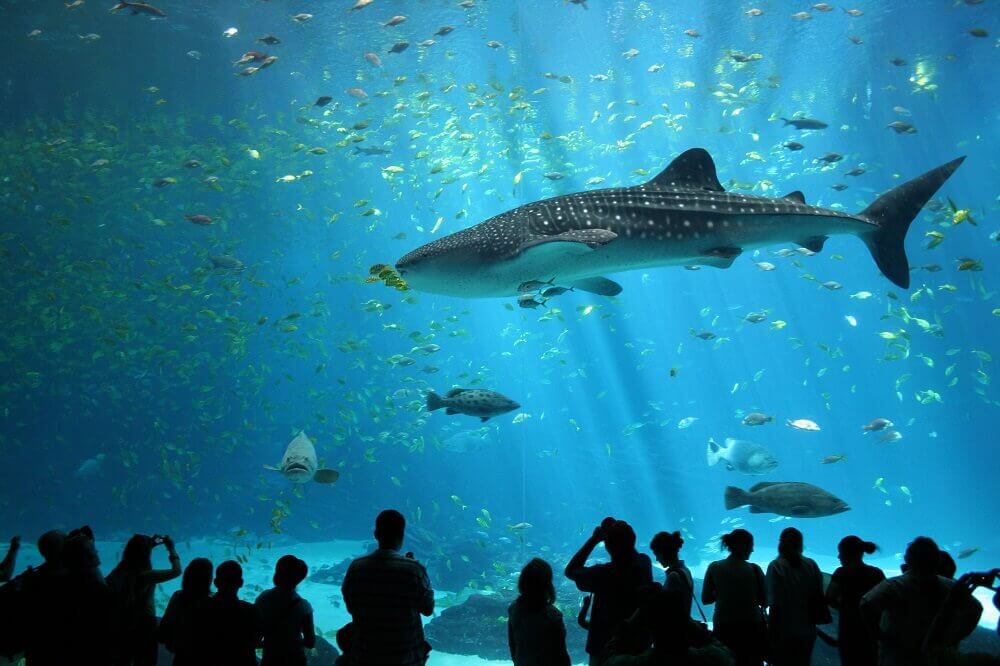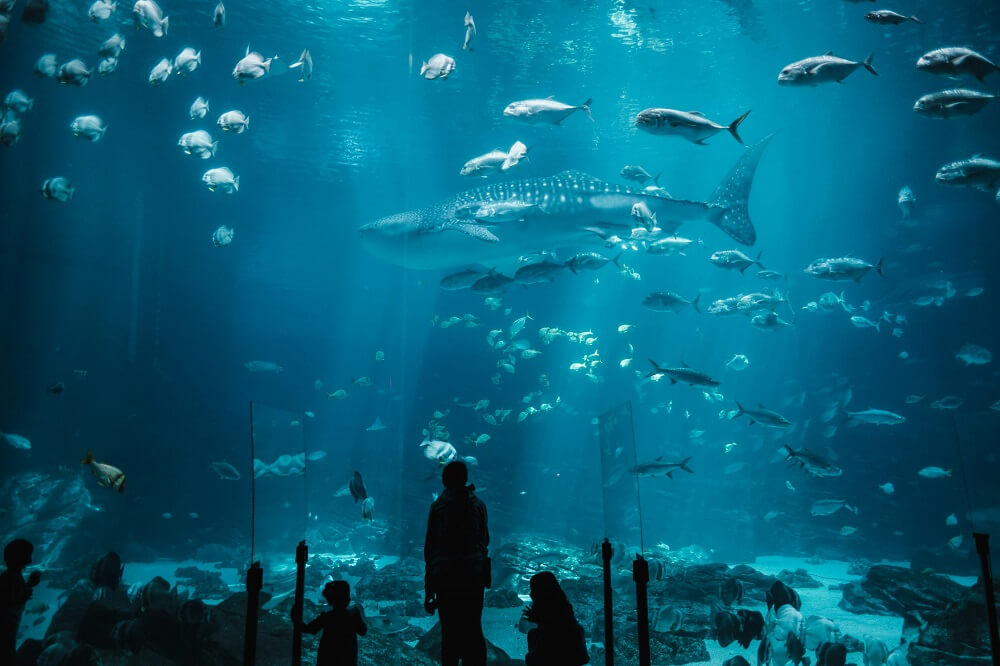The Georgia Aquarium has huge tanks that let visitors see the world’s biggest fish up close. Through special programs, this popular Atlanta spot works to teach people about whale sharks and protect these giants of the sea in the future. To help us understand these mysterious, tropical creatures, the aquarium’s experts use their knowledge and creativity. As a result, the aquarium gives its whale sharks a comfortable home with personalized care based on the latest research. Everyday activities make sure these bus-sized animals show natural behaviors. By sharing what they learn, the Georgia Aquarium hopes more people will understand whale sharks and try to conserve them.
Georgia Aquarium Whale Shark Program
The Georgia Aquarium cares a lot about protecting sea animals, especially whale sharks. They have a special program called the 4R Program, where they study whale sharks to learn more about them. They work with experts to study things like how their bodies work, what they eat, how they grow, and how they behave.
Since not much is known about whale sharks, the Georgia Aquarium’s research is super important for helping to keep them safe all around the world. Their main goal is to use what they learn to make sure whale sharks are protected and can keep living safely in the oceans.
How many Whale Sharks Does the Georgia Aquarium have?
As of March 2023, the Georgia Aquarium has four whale sharks. Although their Ocean Voyager habitat is designed for six full-size whale sharks, only four are currently residing there. This habitat, which holds 6.3 million gallons of water and is equivalent in size to a football field, measures 20 to 30 feet deep. However, concerns have been raised about the inhumane transportation methods used for these animals. Currently, georgia aquarium residents include:
- Two pre-adult females named Alice and Trixie.
- Trixie is recognizable by her pure white belly, while Alice sports spots on hers.
- Two juvenile males named Yushan and Taroko.
- Yushan is distinguished by a u-shaped notch on the trailing edge of his dorsal fin, while Taroko lacks this feature.
- All of our whale sharks were acquired off the coast of Taiwan.
- The females measure approximately 23-26 feet (7-8 meters) in length, while the males are around 20-23 feet (6-7 meters) long.
- Each whale shark consumes an average of 83 pounds (38 kilograms) of food per day, primarily consisting of krill and small fish, which are target-fed using ladles on poles from gantries or small boats.
- Georgia Aquarium Ocean Voyager Exhibit
- The habitat houses thousands of fish species.
- It spans 284 feet (86.5 meters) in length, 126 feet (38.4 meters) in width, and reaches a depth of 30 feet (9 meters).
- Water temperature is maintained at approximately 77°F (25°C), with a salinity of 32-33 parts per thousand (ppt).
- The main viewing window measures 63 feet long, 26 feet high, and 2 feet thick (19×7.9x.6 meters), constructed of acrylic, a material up to 17 times stronger than glass.
- The tunnel acrylic, with a thickness of 6.25 inches (15.8 centimeters), is arched for better water pressure resistance.
- The filtration system is capable of processing all 6.3 million gallons of water in about 60 minutes and comprises 70 pumps, 72 sand filters, and 34 protein skimmers.
How Big is the Whale Shark at Georgia Aquarium?
The whale shark holds the title of being the largest fish in the world, and it’s a true giant of the ocean. Its immense size and unique skeletal structure make it challenging to accurately measure or even fossilize. Let’s delve into the dimensions and characteristics of these remarkable creatures.

Whale Shark Size
While the largest accurately measured whale shark reached an impressive 61.7 feet (18.8 meters) in length, the average size typically falls between 18 and 32 feet (5.5-9.8 meters). Newborn whale sharks are considerably smaller, measuring between 21 and 25 inches (53-64 centimeters) in length.
Mouth Size
The mouth of a whale shark can extend up to an astonishing 4 feet (1.2 meters) across, allowing it to filter large quantities of water for feeding.
Georgia Aquarium’s Whale Sharks
At the Georgia Aquarium, the whale sharks housed in the Ocean Voyager exhibit typically measure between 18 and 32 feet (5.5-9.8 meters) in length. This exhibit, designed to accommodate six full-size whale sharks, spans the size of a football field and ranges from 20 to 30 feet deep.
Physical Characteristics
These majestic creatures are easily recognizable by their distinctive pattern of white spots and stripes against a dark bluish-grey background. While they typically grow to around 12 meters in length, they have been known to reach lengths of up to 20 meters and weigh an impressive 20 tonnes.
Whale Sharks at the Georgia Aquarium
The Georgia Aquarium boasts a remarkable collection of whale sharks. Here’s a breakdown of their whale shark residents:
- Ralph and Norton: These were two male whale sharks who unfortunately passed away in 2007.
- Alice and Trixie: Two female whale sharks, Alice and Trixie, were also part of the aquarium’s collection. Sadly, Alice passed away in 2021, while Trixie passed away in 2020.
- Other Whale Sharks: The Georgia Aquarium’s Ocean Voyager habitat is specifically designed to accommodate up to six full-size whale sharks.
In addition to whale sharks, the aquarium also houses epaulette Sharks. These sharks belong to a species known for its large dark spots above its pectoral fins.
Where did the Georgia Aquarium get their whale sharks?
The Georgia Aquarium did something amazing: it became the first place outside of Asia to have whale sharks. They built a huge tank called the Ocean Voyager, big enough for six whale sharks. To make this happen, they worked with the government of Taiwan and local fishermen to get the right permissions and bring the whale sharks safely. This made the Georgia Aquarium the only place in North America with whale sharks, which are the biggest fish in the world. It was a big deal for aquariums everywhere!
Timeline for Moving Whale Sharks to Atlanta
- Fishermen captured the whale sharks off the East Coast of Taiwan.
- The sharks were placed in a sea pen near Hualien, Taiwan, where Georgia Aquarium whale shark staff trained them to feed horizontally using innovative methods.
- After preparation, the whale sharks were transferred into temporary transport containers mounted on fishing boats.
- They were then transported to Hualien harbor, where they underwent physical exams before being transferred to long-distance transport containers.
- Transport containers, with the whale sharks inside, were flown from Hualien to Taipei and then onto a specially equipped UPS Boeing 747 for the flight to Atlanta.
- Throughout the 22-hour flight, the health of the whale sharks was monitored by aquarium staff, with a stopover in Alaska for refueling.
- Upon arrival at Hartsfield-Jackson International Airport, the transport containers were carefully offloaded onto tractor trailers and transported to the aquarium.
- The whale sharks were acclimated to their new environment by exchanging water from the transport containers with that of the Ocean Voyager habitat.
- After a final physical examination, the whale sharks were released into their new home.
Transportation Methods
Whale sharks can be transported in two ways:
Wet Transit: In this method, the whale sharks are kept in a tank of water during transportation.
Dry Transit: Alternatively, a padded sling is used to keep the whale sharks calm, wet, and cool during transportation.
For air transportation to the Georgia Aquarium, the whale sharks were placed in a specialized shipping container weighing 25,000 pounds. This ensured careful balance on the customized plane. To maintain the well-being of the animals throughout the journey, cabin conditions were carefully regulated, maintaining a low altitude and a mid-70s temperature.
Sea Life Farewell
With its one-of-a-kind whale shark collection, the Georgia Aquarium really stands out. As important representatives of their species, these aquarium animals have amazed over 22 million visitors. Using gentle study methods, the aquarium’s experts keep finding new things about how these huge sea creatures live and act. This research should help global efforts to save declining whale shark groups. Though still quite mysterious, evidence shows these magnificent 60-foot fish play a key role in ocean life. By pioneering whale shark care, health services and field research, the Georgia Aquarium is building a brighter tomorrow. Their work offers hope that these awe-inspiring fish will continue to thrive for generations, swimming freely through vibrant seas.
FAQs
What is the biggest whale shark in the aquarium?
Jinta, the whale shark at Okinawa Churaumi Aquarium, holds a 24-year world record. From arriving as a 4.6-meter youngster in 1995, he’s now grown to an impressive 8.7 meters! The aquarium staff are proud of what they’ve learned about whale sharks’ growth, behavior, and reproduction by caring for Jinta. They hope this knowledge will help protect these creatures in the wild. Despite already weighing 5.5 tons, they believe Jinta might still be growing, as wild whale sharks can reach up to 12 meters long. The team’s dedication to understanding these majestic creatures continues through their ongoing care for Jinta.
Is Georgia Aquarium Ethical?
Yes, the Georgia Aquarium is considered ethical in 2024. This non-profit organization in Atlanta, Georgia, upholds ethical standards in its operations. It is Humane Certified by American Humane and holds accreditations from the Alliance of Marine Mammal Parks and Aquariums and the Association of Zoos and Aquariums, ensuring high animal welfare standards. Recently licensed as a Class R research facility under the Animal Welfare Act, regulated by the United States Department of Agriculture (USDA), the aquarium demonstrates its commitment to ethical review of animal research for advanced scientific understanding.


